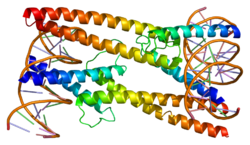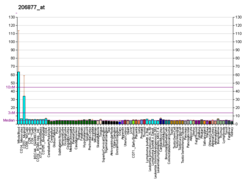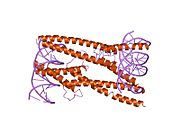Protein-coding gene in the species Homo sapiens
MAD protein is a protein that in humans is encoded by the MXD1 gene .[ 5] [ 6]
MAD-MAX dimerization protein belongs to a subfamily of MAX-interacting proteins. This protein competes with MYC for binding to MAX to form a sequence-specific DNA-binding complex, acts as a transcriptional repressor (while MYC appears to function as an activator) and is a candidate tumor suppressor.[ 6]
Interactions MXD1 has been shown to interact with Histone deacetylase 2 ,[ 7] [ 8] SMC3 ,[ 9] MLX ,[ 10] [ 11] SIN3A [ 12] [ 13] [ 14] MAX .[ 9] [ 15] [ 16] [ 17]
References
^ a b c GRCh38: Ensembl release 89: ENSG00000059728 – Ensembl , May 2017^ a b c GRCm38: Ensembl release 89: ENSMUSG00000001156 – Ensembl , May 2017^ "Human PubMed Reference:" . National Center for Biotechnology Information, U.S. National Library of Medicine .^ "Mouse PubMed Reference:" . National Center for Biotechnology Information, U.S. National Library of Medicine .^ Shapiro DN, Valentine V, Eagle L, Yin X, Morris SW, Prochownik EV (February 1995). "Assignment of the human MAD and MXI1 genes to chromosomes 2p12-p13 and 10q24-q25". Genomics . 23 (1): 282– 5. doi :10.1006/geno.1994.1496 . PMID 7829091 . ^ a b "Entrez Gene: MXD1 MAX dimerization protein 1" .^ Laherty, C D; Yang W M; Sun J M; Davie J R; Seto E; Eisenman R N (May 1997). "Histone deacetylases associated with the mSin3 corepressor mediate mad transcriptional repression" . Cell . 89 (3). UNITED STATES: 349– 56. doi :10.1016/S0092-8674(00)80215-9 ISSN 0092-8674 . PMID 9150134 . S2CID 13490886 . ^ Spronk, C A; Tessari M; Kaan A M; Jansen J F; Vermeulen M; Stunnenberg H G; Vuister G W (December 2000). "The Mad1-Sin3B interaction involves a novel helical fold". Nat. Struct. Biol . 7 (12). UNITED STATES: 1100– 4. doi :10.1038/81944 . hdl :2066/79474 ISSN 1072-8368 . PMID 11101889 . S2CID 12451972 . ^ a b Gupta, K; Anand G; Yin X; Grove L; Prochownik E V (March 1998). "Mmip1: a novel leucine zipper protein that reverses the suppressive effects of Mad family members on c-myc" . Oncogene . 16 (9). ENGLAND: 1149– 59. doi :10.1038/sj.onc.1201634 ISSN 0950-9232 . PMID 9528857 . ^ Cairo, S; Merla G; Urbinati F; Ballabio A; Reymond A (March 2001). "WBSCR14, a gene mapping to the Williams--Beuren syndrome deleted region, is a new member of the Mlx transcription factor network" . Hum. Mol. Genet . 10 (6). England: 617– 27. doi :10.1093/hmg/10.6.617 ISSN 0964-6906 . PMID 11230181 . ^ Meroni, G; Cairo S; Merla G; Messali S; Brent R; Ballabio A; Reymond A (July 2000). "Mlx, a new Max-like bHLHZip family member: the center stage of a novel transcription factors regulatory pathway?" . Oncogene . 19 (29). ENGLAND: 3266– 77. doi :10.1038/sj.onc.1203634 ISSN 0950-9232 . PMID 10918583 . ^ Swanson, Kurt A; Knoepfler Paul S; Huang Kai; Kang Richard S; Cowley Shaun M; Laherty Carol D; Eisenman Robert N; Radhakrishnan Ishwar (August 2004). "HBP1 and Mad1 repressors bind the Sin3 corepressor PAH2 domain with opposite helical orientations". Nat. Struct. Mol. Biol . 11 (8). United States: 738– 46. doi :10.1038/nsmb798 . ISSN 1545-9993 . PMID 15235594 . S2CID 44324333 . ^ Brubaker, K; Cowley S M; Huang K; Loo L; Yochum G S; Ayer D E; Eisenman R N; Radhakrishnan I (November 2000). "Solution structure of the interacting domains of the Mad-Sin3 complex: implications for recruitment of a chromatin-modifying complex" . Cell . 103 (4). UNITED STATES: 655– 65. doi :10.1016/S0092-8674(00)00168-9 ISSN 0092-8674 . PMID 11106735 . S2CID 17476603 . ^ Ayer, D E; Lawrence Q A; Eisenman R N (March 1995). "Mad-Max transcriptional repression is mediated by ternary complex formation with mammalian homologs of yeast repressor Sin3" . Cell . 80 (5). UNITED STATES: 767– 76. doi :10.1016/0092-8674(95)90355-0 ISSN 0092-8674 . PMID 7889570 . S2CID 8749951 . ^ Lee, Clement M; Onésime Djamila; Reddy C Damodara; Dhanasekaran N; Reddy E Premkumar (October 2002). "JLP: A scaffolding protein that tethers JNK/p38MAPK signaling modules and transcription factors" . Proc. Natl. Acad. Sci. U.S.A. 99 (22). United States: 14189– 94. Bibcode :2002PNAS...9914189L . doi :10.1073/pnas.232310199 ISSN 0027-8424 . PMC 137859 PMID 12391307 . ^ Ayer, D E; Kretzner L; Eisenman R N (January 1993). "Mad: a heterodimeric partner for Max that antagonizes Myc transcriptional activity". Cell . 72 (2). UNITED STATES: 211– 22. doi :10.1016/0092-8674(93)90661-9 . ISSN 0092-8674 . PMID 8425218 . S2CID 13317223 . ^ Nair, Satish K; Burley Stephen K (January 2003). "X-ray structures of Myc-Max and Mad-Max recognizing DNA. Molecular bases of regulation by proto-oncogenic transcription factors" . Cell . 112 (2). United States: 193– 205. doi :10.1016/S0092-8674(02)01284-9 ISSN 0092-8674 . PMID 12553908 . S2CID 16142388 .
Further reading
Grandori C, Cowley SM, James LP, Eisenman RN (2001). "The Myc/Max/Mad network and the transcriptional control of cell behavior". Annu. Rev. Cell Dev. Biol . 16 (1): 653– 99. doi :10.1146/annurev.cellbio.16.1.653 . PMID 11031250 . Lüscher B (2001). "Function and regulation of the transcription factors of the Myc/Max/Mad network". Gene . 277 (1– 2): 1– 14. doi :10.1016/S0378-1119(01)00697-7 . PMID 11602341 . Ayer DE, Lawrence QA, Eisenman RN (1995). "Mad-Max transcriptional repression is mediated by ternary complex formation with mammalian homologs of yeast repressor Sin3" . Cell . 80 (5): 767– 76. doi :10.1016/0092-8674(95)90355-0 PMID 7889570 . S2CID 8749951 . Edelhoff S, Ayer DE, Zervos AS, et al. (1994). "Mapping of two genes encoding members of a distinct subfamily of MAX interacting proteins: MAD to human chromosome 2 and mouse chromosome 6, and MXI1 to human chromosome 10 and mouse chromosome 19". Oncogene . 9 (2): 665– 8. PMID 8290278 . Ayer DE, Kretzner L, Eisenman RN (1993). "Mad: a heterodimeric partner for Max that antagonizes Myc transcriptional activity". Cell . 72 (2): 211– 22. doi :10.1016/0092-8674(93)90661-9 . PMID 8425218 . S2CID 13317223 . Hassig CA, Fleischer TC, Billin AN, et al. (1997). "Histone deacetylase activity is required for full transcriptional repression by mSin3A" . Cell . 89 (3): 341– 7. doi :10.1016/S0092-8674(00)80214-7 PMID 9150133 . S2CID 14233219 . Laherty CD, Yang WM, Sun JM, et al. (1997). "Histone deacetylases associated with the mSin3 corepressor mediate mad transcriptional repression" . Cell . 89 (3): 349– 56. doi :10.1016/S0092-8674(00)80215-9 PMID 9150134 . S2CID 13490886 . Gupta K, Anand G, Yin X, et al. (1998). "Mmip1: a novel leucine zipper protein that reverses the suppressive effects of Mad family members on c-myc" . Oncogene . 16 (9): 1149– 59. doi :10.1038/sj.onc.1201634 PMID 9528857 . FitzGerald MJ, Arsura M, Bellas RE, et al. (1999). "Differential effects of the widely expressed dMax splice variant of Max on E-box vs initiator element-mediated regulation by c-Myc" . Oncogene . 18 (15): 2489– 98. doi :10.1038/sj.onc.1202611 PMID 10229200 . Khan MM, Nomura T, Kim H, et al. (2001). "Role of PML and PML-RARalpha in Mad-mediated transcriptional repression" . Mol. Cell . 7 (6): 1233– 43. doi :10.1016/S1097-2765(01)00257-X PMID 11430826 . Strausberg RL, Feingold EA, Grouse LH, et al. (2003). "Generation and initial analysis of more than 15,000 full-length human and mouse cDNA sequences" . Proc. Natl. Acad. Sci. U.S.A . 99 (26): 16899– 903. Bibcode :2002PNAS...9916899M . doi :10.1073/pnas.242603899 PMC 139241 PMID 12477932 . Nikiforov MA, Popov N, Kotenko I, et al. (2003). "The Mad and Myc basic domains are functionally equivalent" . J. Biol. Chem . 278 (13): 11094– 9. doi :10.1074/jbc.M212298200 PMID 12538578 . Nair SK, Burley SK (2003). "X-ray structures of Myc-Max and Mad-Max recognizing DNA. Molecular bases of regulation by proto-oncogenic transcription factors" . Cell . 112 (2): 193– 205. doi :10.1016/S0092-8674(02)01284-9 PMID 12553908 . S2CID 16142388 . Siegel PM, Shu W, Massagué J (2003). "Mad upregulation and Id2 repression accompany transforming growth factor (TGF)-beta-mediated epithelial cell growth suppression" . J. Biol. Chem . 278 (37): 35444– 50. doi :10.1074/jbc.M301413200 PMID 12824180 . Gerhard DS, Wagner L, Feingold EA, et al. (2004). "The status, quality, and expansion of the NIH full-length cDNA project: the Mammalian Gene Collection (MGC)" . Genome Res . 14 (10B): 2121– 7. doi :10.1101/gr.2596504 . PMC 528928 PMID 15489334 . Hillier LW, Graves TA, Fulton RS, et al. (2005). "Generation and annotation of the DNA sequences of human chromosomes 2 and 4" . Nature . 434 (7034): 724– 31. Bibcode :2005Natur.434..724H . doi :10.1038/nature03466 PMID 15815621 . Zada AA, Pulikkan JA, Bararia D, et al. (2007). "Proteomic discovery of Max as a novel interacting partner of C/EBPalpha: a Myc/Max/Mad link" . Leukemia . 20 (12): 2137– 46. doi :10.1038/sj.leu.2404438 PMID 17082780 .
External links Overview of all the structural information available in the PDB for UniProt : Q05195 PDBe-KB .
(1) Basic domains
(1.1) Basic leucine zipper (bZIP )(1.2) Basic helix-loop-helix (bHLH )
Group A Group B Group CPAS Group D Group E Group F
(1.3) bHLH-ZIP (1.4) NF-1 (1.5) RF-X (1.6) Basic helix-span-helix (bHSH)
(2) Zinc finger DNA-binding domains
(2.1) Nuclear receptor (Cys4 )
subfamily 1 subfamily 2 subfamily 3 subfamily 4 subfamily 5 subfamily 6 subfamily 0
(2.2) Other Cys4 (2.3) Cys2 His2 (2.4) Cys6 (2.5) Alternating composition (2.6) WRKY
(4) β-Scaffold factors with minor groove contacts
(0) Other transcription factors







